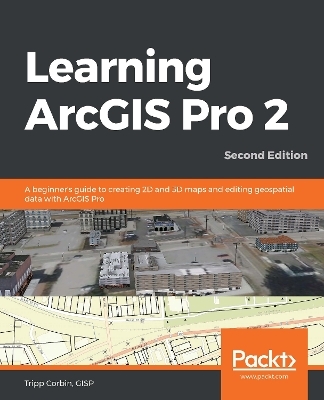
Learning ArcGIS Pro 2
Packt Publishing Limited (Verlag)
978-1-83921-022-8 (ISBN)
Create 2D maps and 3D scenes, analyze GIS data, and share your results with the GIS community using the latest ArcGIS Pro 2 features
Key Features
Get up to speed with the new ribbon-based user interface, projects, models, and common workflows in ArcGIS Pro 2
Learn how to visualize, maintain, and analyze GIS data
Automate analysis and processes with ModelBuilder and Python scripts
Book DescriptionArmed with powerful tools to visualize, maintain, and analyze data, ArcGIS Pro 2 is Esri's newest desktop geographic information system (GIS) application that uses the modern ribbon interface and a 64-bit processor to make using GIS faster and more efficient. This second edition of Learning ArcGIS Pro will show you how you can use this powerful desktop GIS application to create maps, perform spatial analysis, and maintain data.
The book begins by showing you how to install ArcGIS and listing the software and hardware prerequisites. You’ll then understand the concept of named user licensing and learn how to navigate the new ribbon interface to leverage the power of ArcGIS Pro for managing geospatial data. Once you’ve got to grips with the new interface, you’ll build your first GIS project and understand how to use the different project resources available. The book shows you how to create 2D and 3D maps by adding layers and setting and managing the symbology and labeling. You’ll also discover how to use the analysis tool to visualize geospatial data. In later chapters, you’ll be introduced to Arcade, the new lightweight expression language for ArcGIS, and then advance to creating complex labels using Arcade expressions. Finally, you'll use Python scripts to automate and standardize tasks and models in ArcGIS Pro.
By the end of this ArcGIS Pro book, you’ll have developed the core skills needed for using ArcGIS Pro 2.x competently.
What you will learn
Navigate the user interface to create maps, perform analysis, and manage data
Display data based on discrete attribute values or range of values
Label features on a GIS map based on one or more attributes using Arcade
Create map books using the map series functionality
Share ArcGIS Pro maps, projects, and data with other GIS community members
Explore the most used geoprocessing tools for performing spatial analysis
Create Tasks based on common workflows to standardize processes
Automate processes using ModelBuilder and Python scripts
Who this book is forIf you want to learn ArcGIS Pro to create maps and, edit and analyze geospatial data, this ArcGIS book is for you. No knowledge of GIS fundamentals or experience with any GIS tool or ArcGIS software suite is required. Basic Windows skills, such as navigating and file management, are all you need.
Tripp Corbin, GISP, has over 25 years of experience in the geospatial industry and is recognized as an industry expert in a variety of geospatial software platforms, including Esri, Autodesk, and Trimble products. He has assisted numerous organizations in implementing GIS to help solve problems and improve operations. He holds multiple certifications, including as a certified GIS professional, Esri-certified enterprise system design associate, and Esri-certified desktop professional. He is also the former president of URISA and the local Georgia Chapter. In recognition of his contributions to the GIS community, he has received several awards, including the URISA Exemplary Leadership award and the Barbara Hirsch Special Service award.
Table of Contents
Introducing ArcGIS Pro
Navigating the Ribbon Interface
Creating 2D Maps
Creating 3D Scenes
Creating and Working with Projects
Creating a Layout
Creating Map Books using Map Series
Learning to Edit Spatial Data
Learning about Editing Tabular Data
Performing Analysis with Geoprocessing Tools
Creating and using Tasks
Automating Processes with ModelBuilder and Python
Sharing Your Data with Others
Using Arcade expressions for labeling & symbology
| Erscheinungsdatum | 29.07.2020 |
|---|---|
| Verlagsort | Birmingham |
| Sprache | englisch |
| Maße | 75 x 93 mm |
| Themenwelt | Mathematik / Informatik ► Informatik ► Grafik / Design |
| Mathematik / Informatik ► Informatik ► Programmiersprachen / -werkzeuge | |
| ISBN-10 | 1-83921-022-2 / 1839210222 |
| ISBN-13 | 978-1-83921-022-8 / 9781839210228 |
| Zustand | Neuware |
| Informationen gemäß Produktsicherheitsverordnung (GPSR) | |
| Haben Sie eine Frage zum Produkt? |
aus dem Bereich


